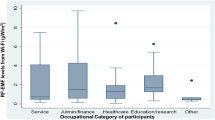Abstract
Objectives
The proportion of general practitioners (GPs) in Germany who assume health impacts of electromagnetic fields (EMF) is assessed. Moreover, factors associated with this risk perception are examined.
Methods
A 7% random sample was drawn from online lists of all the GPs working in Germany. 1,867 doctors received a long version of a self-administered postal questionnaire about EMF and health (response rate 23.3%), 928 doctors received a short version (response rate 49.1%).
Results
37.3% of responders to the short and 57.5% of responders to the long questionnaire agreed “that there are persons whose health complaints are caused by EMF when legal limit values are met”. A late responder analysis for the survey with the short questionnaire led to a still lower estimate of 29% for GPs believing in health-relevant effects of EMF.
Conclusion
About a third of German GPs associate EMF with health complaints and thus deviate considerably from current scientific knowledge. To avoid a strong selection bias in the surveys of the perception of EMF risks, use of short questionnaires and late responder analysis are recommended.
Similar content being viewed by others
References
Armstrong JS, Overton TS (1977) Estimating nonresponse bias in mail surveys. J Mark Res 14:396–402
Berg-Beckhoff G, Blettner M, Kowall B, Breckenkamp J, Schlehofer B, Schmiedel S, Bornkessel C, Reis U, Potthoff P, Schüz J (2009) Mobile phone base stations and adverse health effects: phase 2 of a cross-sectional study with measured radio frequency electromagnetic fields. Occup Environ Med 66:124–130
Blettner M, Schlehofer B, Breckenkamp J, Kowall B, Schmiedel S, Reis U, Potthoff P, Schüz J, Berg-Beckhoff G (2009) Mobile phone base stations and adverse health effects: phase 1 of a population-based, cross-sectional study in Germany. Occup Environ Med 66:118–123
Edwards P, Roberts I, Clarke M, Diguiseppi C, Pratap S, Wentz R, Kwan I (2002) Increasing response rates to postal questionnaires: systematic review. BMJ 324:1183
Hillert L, Berglind N, Arnetz BB, Bellander T (2002) Prevalence of self-reported hypersensitivity to electric or magnetic fields in a population-based questionnaire survey. Scand J Work Environ Health 28:33–41
Huss A, Röösli M (2006) Consultations in primary care for symptoms attributed to electromagnetic fields–a survey among general practitioners. BMC Public Health 6:267
INFAS (Institut für angewandte Sozialwissenschaft). [Determination of concerns and fears in the public with regard to potential risk of radiofrequency electromagnetic fields—annual survey 2006] Ermittlung der Befürchtungen und Ängste der breiten Öffentlichkeit hinsichtlich möglicher Gefahren der hochfrequenten elektromagnetischen Felder des Mobilfunks – jährliche Umfragen. Abschlussbericht. http://www.emf-forschungsprogramm.de/forschung/risikokommunikation/risikokommunikation_abges/risiko_021.html. Accessed 04 Mar 2009
Kraus N, Malmfors T, Slovic P (1992) Intuitive toxicology: expert and lay judgments of chemical risks. Risk Anal 12:215–232
Leitgeb N, Schröttner J, Böhm M (2005) Does “electromagnetic pollution” cause illness? An inquiry among Austrian general practitioners. Wien Med Wochenschr 155:237–241
Levallois P, Neutra R, Lee G, Hristova L (2002) Study of self-reported hypersensitivity to electromagnetic fields in California. Environ Health Perspect 110(Suppl 4):619–623
Purvis-Roberts KL, Werner CA, Frank I (2007) Perceived risks form radiation and nuclear testing near Semipalatinsk, Kazakhstan: a comparison between physicians, scientists, and the public. Risk Anal 27:291–302
Schreier N, Huss A, Röösli M (2006) The prevalence of symptoms attributed to electromagnetic field exposure: a cross-sectional representative survey in Switzerland. Soz Praventmed 51:202–209
Seitz H, Stinner D, Eikmann T, Herr C, Röösli M (2005) Electromagnetic hypersensitivity (EHS) and subjective health complaints associated with electromagnetic fields of mobile phone communication–a literature review published between 2000 and 2004. Sci Total Environ 349:45–55
Acknowledgments
The study received funding entirely from the German Federal Ministry for the Environment, Nuclear Safety, and Nature Protection. (Project number: St.Sch. 4545) The study sponsor had no involvement in study design; in the collection, analysis, and interpretation of data; in the writing of the report; and in the decision to submit the article for publication.
Conflict of interest statement
All authors declare that the answer to the questions on the competing interest form are all no and therefore have nothing to declare.
Author information
Authors and Affiliations
Corresponding author
Rights and permissions
About this article
Cite this article
Kowall, B., Breckenkamp, J., Heyer, K. et al. German wide cross sectional survey on health impacts of electromagnetic fields in the view of general practitioners. Int J Public Health 55, 507–512 (2010). https://doi.org/10.1007/s00038-009-0110-2
Received:
Revised:
Accepted:
Published:
Issue Date:
DOI: https://doi.org/10.1007/s00038-009-0110-2




